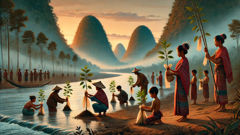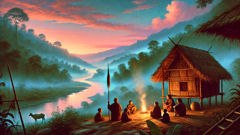Introduction
On the steep slopes and green hollows of the Karbi Hills, where mist moves like prayer and rivers remember the feel of pebbles, there exists a creation tale that carries soil, seed, and silence together. This is not a history carved from stone but a breath of story passed mouth to ear across woven bamboo verandas, around hearth fires, and under the tall canopies of sal and bamboo. In that telling the world grew from a single, improbable thing: a gourd as large as a hill, living and humming with hidden life. The gourd, in the old telling, is not merely vegetable but vessel and womb, a map of relationship and a laboratory of becoming. From its stem unfurled mountains and plains; from its hollow poured rivers and the first small songs; inside it hid creatures that would learn to walk and speak and become the ancestors of the Karbi people. This retelling aims to respect the tone of that origin story, to linger on the textures—moss, ash, clay, rope—and on the human gestures that echo ritual practice without presuming accuracy where only memory and myth remain. We move through the gourd's birth and cracking, through the first light like a slow lens, and into the delicate ethics of naming and tending that shape Karbi life. As with all origins, the tale is at once an attempt to understand the landscape and a promise to live within it, to honor each stream and every root. It asks us to listen closely, to let breath and bird-call translate into the verbs of making and tending, and to remember that creation myths are less about factual beginnings than about how people teach themselves to belong.
The Birth of the Great Gourd and the First Sounds
Long before the first lime-stone terrace or the first terrace house, before the names that now sit on maps, the Karbi Hills were a place of deep quiet interrupted by small, curious sounds: the clack of insects, the sigh of bamboo, the distant call of hornbill. When the world was still in the hands of unshaped things, there came into being a plant seed that would not behave like other seeds. It fell into a damp cleft where a deer had died and where the rain kept counting seasons as if each were a bead. The seed was heavy with unknown hunger; it drank moonlight as much as rain and responded to a low, subterranean music, a pulse like heartbeat from some older earth. From that seed grew a vine that coiled and uncoiled in long silver loops, and at its center hung a gourd the size of a house. The people who would later become the Karbi tell the gourd as both miracle and ordinary: a vegetable grown too large for good reason, a vessel waiting to be opened.

At first, no one lived in the hills, because there was no speech that could name things with confidence. But things make noises, and noises invite attention. The gourd gave off a sound like a throat clearing: a low hum that set moss into ripple and made the small stones vibrate in answer. Animals came first—curious, skeptical—foxes whose eyes caught starlight, a pair of langurs who swung down to inspect the shine. They listened, and when they started to hum back, the gourd responded by changing shape. Its stem lengthened like a wrist; its rind took on patterns like rivers seen from a bird's eye. Night after night the hum widened into notes, and notes became syllables. From within its shell there came a single word that translated in the air as a kind of invitation: come. In the archaic pulse of the world, invitation was equivalent to instruction.
A figure then appeared where no person had been made yet: an ancestor-shaped presence whose outline was more careful breath than anatomy. She had hands the color of wet clay and eyes that reflected the gourd's patterns. Some tellers name her Aso, others blur the name, but all agree on her work: she opened the gourd with a kind of reverence that resembles a harvest. She did not cut; she unbuttoned, easing the seam until the shade inside rolled outward. The first light was not like the clean, high light of noon but soft, like embers reborn. When the gourd split, a slow river poured from it and wrapped itself into gullies, learning to be river by seeking the low places. The seeds nested in the gourd's pockets leapt and settled; some became trees, some fish, some stone. In the first day those newly-formed things made a pact: they would keep their own shapes and be generous with shelter. The gourd had taught them how to be bound and boundless at once.
You might imagine the gourd's insides as a simple storehouse. They were not. Inside were lessons: how to make bread from wild grasses, how to braid reed for roofs, how a song might become a map. The animals inside learned to speak in ways that humans could later decode, each sound attaching to a feature of land. The hornbill learned to name the high trees; the river learned to call the low stones by their right names; the leopard learned to be both shadow and guardian. These names became the first law, the map that guided footsteps. Yet the gourd also taught an ethic of reciprocity. Where the people would one day plant, they were taught to leave a margin for the forest; where they would take fruit, they were taught to return seeds beneath a stone. From the gourd the world learned that to make is also to owe. And so the first people, when they emerged—not quite finished, not perfect—brought with them a vocabulary of tending. They spoke not to conquer but to ask, and their words were often shaped as question. To name, then, was a way to promise care.
As seasons turned, the descendants of that opening multiplied, spread, and learned craft. Their woven mats kept memory; their flute songs carried the cadence of the gourd's hum. They discovered how to use fire without arrogance, how to smoke fish in ways that honored the streams, how to braid ritual into ordinary work. Every gardening season included a small motion of thanks to the hole from which the world had poured. Sages among them began to thread stories together, making genealogies that tied the clans back to small gestures at the gourd's rim. This practice of connecting ancestry to landscape became a blueprint for identity: a way to know who one was by knowing which stream one came from, which hill one's grandmother had once planted millet upon. Even the simplest daily acts—mending a roof, driving a buffalo, planting a seed—were understood as continuations of the first careful work done at the mouth of the gourd. In time the gourd itself became more than origin; it became a living symbol of relationship, an idea that taught patience as much as creation. People learned that the world was not merely a backdrop for human projects but a companion whose gifts demanded attentive response. The story of the great gourd remained a kind of contract: to be Karbi was to remember that the world had once been small and offered itself whole, that abundance was an arrangement, not entitlement.
Naming, Ritual, and the Ethics of Tending
The Karbi creation tale continues not merely as narrative but as instruction for living. After the first emergence from the gourd, the people faced the task that everymaker faces: what to call things, what habits to set, and which debts to honor. Naming was never a trivial act in this myth; it was performative and formative. When the first mother—ancestors call her by gentle titles that vary with region—gave names, she did so with the care of one teaching a child to walk over stone. A name could hold climate and craving, could remind a listener of past floods and the way a certain slope gathered sun. Thus, to speak the name of a hill was to recall the hill's appetite and its capacity to shelter. Names became small contracts of attention. Those who cared for water learned how to speak to it; those who cared for trees learned how to listen for the slow complaint of dying branches.

Ritual in the post-gourd world proved less like strict ceremony and more like repeated practice shaped to keep relationships alive. Each village developed rites that traced back to the gourd's opening: sprinkling ash in a new field to remember the dark interior where seeds were held, tying a strip of cloth to a young sapling to mirror the vine that had cradled the gourd, singing a low hum before cutting a big limb so that the tree might be honored as both provider and neighbor. The ethics embedded in these acts placed limits on taking. Those who ignored them were said to meet small but telling misfortunes—failed crops, the quieting of children's laughter—used by elders not as punishment but as a teaching mechanism: the land remembers and responds.
There are many layers to the ritual life drawn from the gourd story. One is practical: an instruction manual in mythic form for sustainable use of resources. Another is metaphysical: an account that asserts human beings are not the only agents; stones, rivers, and trees retain spirits and voices. A third layer is social: rituals were modes of gathering and reconciling, spaces where disputes about land or marriage could be translated back into shared responsibilities. In the mythic memory, a particular river had its own counsel as to who might fish in which bend during which season. Consent mattered between humans and waters; so did precedence among kin. These practices helped the community to manage scarcity without violence and to cultivate abundance without erasure. They were governance by story.
The myth also teaches about the origins of tools and craft. The first weavers learned to imitate the vine's coil, the potters copied the gourd's curves, and the people of the hills became skilled at turning shapes into shelter. Such skills were not framed as mere technique but as forms of listening to the gourd's intelligence. To spin a basket was to rehearse the way the vine had held fruit; to shape a pot was to recall the gourd's mute offer. Even the smallest decorative motifs in cloth and tattoo echoed the gourd's ribbed surface. These patterns functioned as memory devices, visual cues that linked daily labor back to the origin moment. Over generations, craftsmen and craftswomen preserved mythic knowledge by embedding it into goods used in marriage rites, funerals, and harvest festivals. The production of objects became a means of cultural continuity.
Beyond craft and ceremony, the gourd myth shaped interpersonal values. Hospitality, for example, is explained as a continuation of the gourd's openness. When the gourd first cracked, what emerged were not only resources but a model of sharing: the river flowed to the low lands, the fruit fell to the valley floor. In local ethic, to offer food to a guest is to re-enact that feeding of the world; to refuse is to deny the gourd's generosity. Similarly, the myth instructs on inter-clan relations. Those who could trace distant kin to a particular pocket of the gourd were bound by obligation to one another; disputes were not simply private matters but questions about how faithfully the present generation honored the seam from which all had been unstitched. The gourd thus functions as both origin and blueprint for community justice.
Importantly, the story is also a conversation with landscape change. The Karbi Hills have known shifting climates, migration, and varying pressures from neighboring polities. In retelling the gourd, storytellers encoded strategies for resilience: diversify crops, guard seed lines, and leave corridors for wildlife. When modern pressures arrived—roads, commercial agriculture, outside governance—elders would sometimes speak of the gourd to remind younger people that a world founded on reciprocity is less fragile. The gourd's ethics resist simplistic nostalgia; they are pragmatic instructions layered in poetic form. They ask current generations to consider what it means to keep obligations to water and tree when market demands push otherwise.
For those who seek to honor indigenous narratives while learning from them, the Karbi gourd story offers a model: myths can be sources of environmental wisdom, community cohesion, and an ethic of care that survives through adaptation. It is not a manual one reads once but a song one returns to, each noted verse teaching new skill depending on the season. The gourd continues to be a living emblem in many practices, invoked in prayers and woven into festival songs, its memory acting as a bridge between ancestral guidance and present-day challenges. In this way, the creation tale remains both explanation and invitation: explanation for why the hills and streams are as they are, and invitation to live as co-stewards of a world that once poured itself out, trusting that those who listen might learn to keep its promises.
Conclusion
The myth of the Karbi creation story—of a world poured from a great gourd—functions as both a portrait and a promise. It paints a landscape whose contours are ethical as much as physical, a terrain where rivers are teachers and gourds become law. To re-tell this myth is to recognize the ways stories shape stewardship: they give names to what must be kept, they ritualize restraint, and they provide metaphors for resilience. The gourd instructs that abundance and humility belong together, that creation is not a single event but an ongoing practice of tending and returning. As the Karbi people have shown, living by a myth means translating its images into daily acts—planting with gratitude, naming with care, and tending relations with patience. That is the most enduring lesson of the gourd: the world can be born more than once, whenever a community chooses to remember its debts and keep its promises to the land and to one another.













